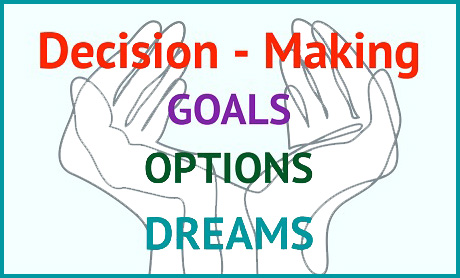 Q: What is Supported Decision-Making?
Q: What is Supported Decision-Making?
Supported decision-making (SDM) allows individuals with disabilities to make choices about their own lives with support from a team of people. Individuals with disabilities choose people they know and trust to be part of a support network to help with decision-making.
Supported decision-making is an alternative to guardianship. Guardians make decisions for the person with a disability. However, supported decision-making allows the person with the disability to make his or her own decisions instead of having someone else make them.
Supported decision-making promotes self-determination, control, and autonomy. It fosters independence.
We all engage in supported decision-making. We consult with family or friends, colleagues or classmates, mechanics or mentors before we make decisions. We may seek support to decide whether to go on a blind date, buy a used car, change jobs, renew a lease, or undergo cataract surgery. We confer and consult with others, and then we decide on our own.
People with disabilities may need assistance making decisions about living arrangements, health care, relationships, and financial matters. But they do not necessarily need a guardian to make those decisions for them. A trusted network of supporters can field questions and review options to help the person with the disability make their own decisions. Supporters are selected by the person with the disability. They can be family members, co-workers, friends, and past or present providers. The individual should select supporters who know and respect his or her will and preferences, and who will honor the decisions the individual makes.
Q: Why is Supported Decision-Making important?
People under guardianship experience a kind of “civil death” because they lose the right to make their own decisions about important matters. Their guardian makes choices for them about major life issues including their personal health care, finances, whether to marry and raise a family, with whom to associate, and other day-to-day decisions.
At least 1.5 million adults in the United States are under guardianship, but the number could be as high as 3 million, given the remarkable dearth of data. The number of individuals with intellectual or developmental disabilities (I/DD) under guardianship is expected to increase over the next few decades. Due to enhanced medical care, many people with I/DD will outlive their parents and family caregivers. Data suggest that by the year 2030, there will be several million individuals with intellectual disabilities over the age of 60 years in the U.S. who may need help with decision-making and for whom guardianship is considered.
At the same time that guardianship numbers are increasing, there has been what disability experts call a “paradigm shift” away from the overly protective construct of guardianship toward the more rights-focused construct of supported decision-making.
Though supported decision-making is just gaining a foothold in the United States, this concept has been evolving in other countries for more than a decade. Several countries have long found that everyone – including individuals with disabilities – has legal capacity to make decisions. This concept was further advanced when the United Nations Convention on the Rights of People with Disabilities voted in 2006 to adopt Article 12. It states that “persons with disabilities enjoy legal capacity on an equal basis with others in all aspects of life” and that “[all] parties shall take appropriate measures to provide access by persons with disabilities to the support they may require in exercising their legal capacity.”
This shift of thinking away from plenary guardianship and substituted decision-making toward supported decision-making is the foundation of the Center for Public Representation’s work on supported decision-making.
Q: What are some examples of tools used in Supported Decision-Making?
- Plain language materials or information in visual or audio form
- Extra time to discuss choices
- Creating lists of pros and cons
- Role-playing activities to help the person understand choices
- Bringing a supporter into important appointments to take notes and help the person remember and discuss their options
- Bill payment tools such as auto-payments or bill management notification apps
Questions 1 & 2, from the Center for Public Representation; Q3 from Supportmydecision.com, a project of the Disability Rights Maine.

 .
.